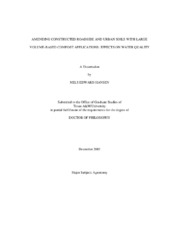| dc.description.abstract | Mineral nutrients imported in composted dairy manure (CDM) and municipal
biosolid (CMB) amendments for highway-rights-of-way and urban landscapes can pose
a threat to surface water quality. Treatments were developed to evaluate
recommendations for amending roadside and urban soils with compost at large volumebased
rates. Texas Department of Transportation (TxDOT) recommendations were
evaluated in 2002 and 2003. Municipal recommendations were evaluated in 2004.
Treatments were imposed on 4 by 1.5-m field plots on a constructed soil with an 8.5%
slope. Three TxDOT compost application methods were tested; incorporation at 25% by
volume (CMT), topdressing over vegetation (GUC), and topdressing a 5-cm compost
woodchip mix over bare soil (ECC). In 2003, a 12.5% CMT treatment was substituted
for the GUC, and two contrasting composts were compared. In 2002, soil test
phosphorus (STP) concentrations (mg kg-1) were 291, 360, 410, and 1921 mg kg-1 in the
0 to 5-cm layer of a course textured CMT, fine textured CMT, GUC, and ECC
treatments, respectively using CDM. In 2003, STP concentrations were 264, 439, 496,623, 1115, and 2203 mg kg-1, in the 0 to 5-cm layer after incorporation of CDM and
CMB at the 12.5 and 25% volume-based rates, and topdressing the 5-cm CDM- or
CMB-woodchip mix over bare soil, respectively. In 2004, contrasting CMB products,
relatively low or high in total phosphorus (TP) were incorporated into the soil at 12.5
and 25% by volume, or imported in transplanted sod at the 25% by volume rate. The
STP concentrations were 87, 147, 180, 301, 322, and 544 mg kg-1, respective to the
previously defined treatments. Runoff water from 14, 10, and 8 natural rain events was
used to characterize nutrient and sediment transport in 2002, 2003, and 2004,
respectively. Concentration of TDP in runoff water was highly variable for roadside
treatments across rain events. Mass losses of TDP were similar after CDM or CMB
were incorporated into the soil at 12.5 and 25% by volume. Compost incorporation was
the most effective method for limiting TP loss in runoff. Roadway and urban soils are
expected to contribute greater TP losses as P concentration increases in soils. | en |


